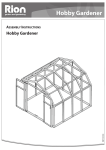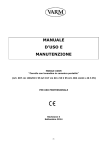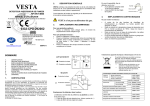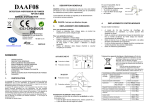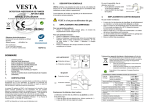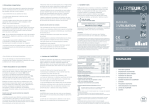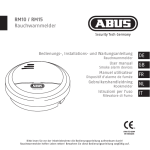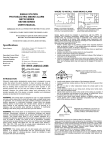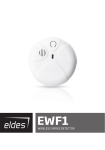Download Bosch WLSD3000
Transcript
Installing and Operating Instruction Model S Smoke Detector Functional Characteristics Battery run smoke detector operating according to the Tyndall effect Suitable for installation in mobile recreation vehicles (subject to extended testing according to DIN EN 14604 for a high resistance to changing temperatures) Elevated range of temperature from -10oC … up to 60oC Smoke intrusion conduct exactly specified Secured against false alarm by powerful measuring chamber Instant and fail-safe fire detection due to exact alignment of the triggering parameters Enhanced operating security due to intelligent signal analysis of the measuring chamber Elaborated automatically generated self control of the electric system Interface for optional upgrade with a radio- or a relay-module Environmental friendly operation due to replaceable batteries Interface to Radio-Controlled Fire Alarm System Operating and Alerting Signals Signal Acoustic signal -sonorous interval tone sonorous interval tone Short signal tone every 40s Short signal tone every 40s LED meaning flash every 40s flashes twice automatic self-testing, normal operating mode local smoke alarm or functional test - smoke alarm at a networked smoke detector malfunction / pollution flash, alternating with acoustic signal flash according to acoustic signal indicates battery replacement Serial Number and Type Label The smoke alarm detector comes with an interface enabling an optional upgrade to various SeCa radiocontrolled fire-alarm systems (e.g. SeCa Power Line, SeCa CC100PREMIUM…) Relay Module Interface for a relay module to connect to an external sensor or coupling to an EIB etc. For detailed information please consult the corresponding manual. Function Principle The smoke alarm detector will identify a fire early, detecting its smoke emission. It works according to the scattered light principle (Tyndall-effect): the arrangement of light emitters and receivers inside the measuring chamber keep emitted light signals from hitting straight into the receiver (optical cell). Should smoke enter inside the box through the smoke inlet apertures the floating smoke particles will scatter the light signal. Those scattered light rays will hit the optical cell and be transformed into an electric signal. The fire alarm will be triggered. Functioning of smoke evaluation is constantly checked. Potential nonconformities will be notified by malfunction signals (acoustic signal or LED). Maintenance and Support Installation and maintenance of the devices have to comply with DIN 14676 including a leastwise annual maintenance, a visual inspection, a functional test as well as a replacement, if indicated, of the battery. Please refer also to description page 2. Please Note 1. 2. 3. 4. 5. . 6. 7. Manual-RWMS-E-1001629, Edition 10012011 Do not use rechargeable batteries or power supply units. The smoke alarm detector generates a sharp, piercing tone that might damage your sense of hearing. Please keep a minimum distance of 50cm between smoke alarm detector and your ear whilst testing the unit. Do not paint the unit. The smoke alarm detector is not to fit in rooms below a temperature of -10oC or superior to 60oC. The smoke alarm detector should not be mounted onto environments like: 5.1. spaces that generate strong emissions of steam (e.g. kitchens, bathrooms, lavatories) 5.2. spaces near fireplaces and firesides 5.3. vicinity of flues (e.g. near air condition or circulated air systems) 5.4. gables (e.g. pediments) Please keep an installation distance of 50cm minimum to light bulbs. The smoke alarm detector is admitted for indoor use only. side 1 Installing and Operating Instruction Model S Smoke Detector Installation and Commissioning 1. 2. 3. 4. 5. 6. Assign place of installation at the ceiling. Take into account the previous chapter “Please Note”. Make use of the provided pins and screws to fix the device to the ceiling; use for drilling (6mm diameter) the device’s base as pattern. Please pay attention to power lines. The device should not get damaged by bore dust. Attach the battery (attention to the poles) and insert it into the designated case. Place the device onto its base. Fix it by turning it clockwise. Check, if the LED flashes at intervals of 40s. This indicates the normal operating mode. Execute a performance test as described in the chapter below. Visual Verification and Performance Test 1. 2. 3. Execute a visual verification of the smoke alarm detector and check the smoke inlet apertures for rough dirt and the entire device for mechanical damage. If so, the device needs to be exchanged. Execute a functional analyse. Push the device’s test button at least 1s. If you get an acoustic signal the smoke detector functions properly. If the acoustic signal fails to appear, change the battery and repeat the test. If again the detector does not produce a sound, the detector is broken and needs to be replaced. Battery Replacement 1. 2. 3. 4. 5. Take the smoke detector off, turning it anticlockwise. Replace the used battery by a new one (attention to the poles) and put it into the designated case. Place the device onto the base and fix it by turning it clockwise. Check if the LED flashes at intervals of 40s. This indicates the normal operating mode. Execute a performance test as described in the chapter above. Technical Data Detection principle: Alarm indicator: Operating voltage: Recommended type of battery: Battery life cycle: Operating temperature: Monitored area: Individual display: Acoustic signal: Certified according to: Weight: Dimensions, incl. base: Shelf life: Box material: VdS certification: Manufacturer Warranty You will receive the smoke alarm detector with a 2 year manufacturer warranty as from date of purchase. This warranty comprises rework and replacement with a device at manufacturer’s option, if features are affected or not met, due to material and assembling damages. Compensation for consequential loss is excluded from any kind of warranty. As far as this warranty clause does not specify anything different, common warranty rules according to our general terms and conditions will be applied. Manufacturer warranty of the smoke detector is limited to conventional operation according to this operating manual. Exempted from any kind of warranty is regular wear, damages due to alteration and pollution, as well as missing, inaccurate or unauthorized maintenance of the device. Appropriate Behaviour in Case of Fire Emergency Alarming: Immediately alert the fire brigade. Keep quiet and reply explicitly to the questions you will receive: Where is the seat of the fire located? Which objects are burning? How many injured persons can be identified? Who is calling? Wait for questions asked by the operations control centre. Rescuing: Save yourself as well as persons at risk and get out of any hazard area. Keep to the ground if smoke emission gets strong and compress a damp fabric to nose and mouth. Do not use elevators. Shut doors and windows to inhibit the propagation of fire and smoke. If no escape out-of-doors is possible, look for a safe space, shut the door, keep to the window and draw attention to yourself. Seal off door gaps with damp fabrics or towels to prevent smoke intrusion. Fire Extinction: Try to put out the origin of the fire with fire-fighting equipment at hand. Small seats of fire mostly can be put out with a blanket. Never try to put out a chip pan fire with water but cover the fire with a lid. Tyndall effect Visual and acoustic 9V 9V alkaline cell, type 6LR61, code-no: 5100152; 9V lithium cell, type CR9V/P, Code-no: 5100151 2 years type alkaline cell; 10 years lithium cell - without radio module. Due to extreme environmental conditions the battery’s life cycle maybe reduced. -10oC up to 60oC max. 60m2 up to 6m height LED, red >85 dB(A)/3m EN14604:2005 20g 100x55 Max. 2 years ABS G202055 Manual-RWMS-E-1001629, Edition 10012011 side 2


